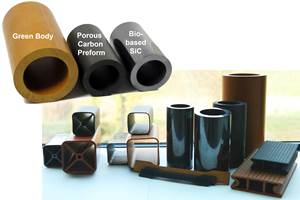WSU-NIAR awarded $13.5 million for high-speed missile materials research
Partnership with Spirit AeroSystems will develop manufacturing processes and material characterization for advanced composites for future thermal protection systems.

The Partnership 2 building on Wichita State's Innovation Campus houses Spirit AeroSystems' WSU location. Photo Credit: WSU-NIAR
The National Institute for Aviation Research (NIAR, Wichita, Kan., U.S.) at Wichita State University announced a new $13.5 million award from the U.S. Army Combat Capabilities Development Command Aviation & Missile Center (CCDC AvMC) for continued applied research on emerging materials for high-speed missile applications.
The research program, which started in 2019, supports CCDC AvMC’s objectives to reduce weight and cost of advanced missile systems while increasing performance. The additional $13.5 million award will allow NIAR to continue to collaborate with CCDC AvMC to expand material testing, characterization and qualification capabilities.
Throughout the first year of the program, researchers reportedly identified technology gaps — such as cost, understanding of processing techniques and lack of data — that limit the use of high-temperature materials, and developed a plan to address them.
Similar to the first phase of the program, NIAR says it will continue to work on various high-temperature-capable material systems with national industry experts, including Spirit AeroSystems (Wichita, Kan., U.S.) and Fiber Materials Inc. (FMI, Biddeford, Maine, U.S.), a Spirit AeroSystems company. Through this partnership, NIAR and Spirit will develop manufacturing processes and material characterization for advanced composites for future thermal protection systems.
“With 50 years of flight-proven materials, Fiber Materials, Inc., now a Spirit AeroSystems company, is a proven industry leader in materials for extreme flight conditions,” says Duane Hawkins, senior vice president and president, Defense, Spirit AeroSystems. “Spirit also brings distinctive materials and production capabilities that complement NIAR’s research and test expertise to support this high-priority national defense program.”
This research, says NIAR, has potential to optimize fabrication processes that enable high rate affordable production of advanced composite components. Other areas of research under the program are focused on ceramic matrix composites (CMC) and high-temperature polymer matrix composites.
“This program diversifies our portfolio for the Army and Department of Defense (DoD),” says John Tomblin, WSU vice president of Industry and Defense programs. “While part of our staff is focused on sustainability for the existing fleet of military vehicles such as the B-1B and Black Hawk, others are focused on emerging technologies and priorities, such as hypersonic warfighting capabilities.” Delivering hypersonic weapons is one of the DoD’s highest technical research and engineering priorities.
U.S. Senator Jerry Moran has been an integral supporter and partner for increased visibility of WSU-NIAR’s capabilities with the DoD.
“The Army’s hypersonics program will greatly benefit from research done at the National Institute for Aviation Research,” adds Sen. Jerry Moran (R-Kan.). “I am confident the strong relationship that has developed between the Army and Wichita State University will continue to provide value to this strategic program and many others, and I look forward to future opportunities that emerge from this collaboration.”
The program currently employs two dozen WSU students gaining applied learning experience through research and material testing. Last fall Peter Dinicola, sophomore in mechanical engineering, transitioned from serving in the Marine Corps Air Station Cherry Point to a full-time engineering student. Dinicola has contributed to the program through his research in hypersonic materials, including CMC fabrication and processing, powder-bed fusion additive manufacturing (AM) and design for manufacturability.
“Participating in the CCDC AvMC emerging materials program has provided me with the opportunity to not only work with a knowledgeable, supportive team, but also to learn and contribute to exciting high-temperature materials research,” says Dinicola.
Related Content
Bio-based SiC ceramics from wood polymer composites
Austrian research institute Wood K plus makes 95% silicon carbide ceramics more sustainable (>85% bio/recycled content), enables 3D shapes via extrusion, injection molding and 3D printing.
Read MoreCarbeon C/C-SiC ceramic matrix composites without fiber coating
Dutch startup Arceon is working with leaders in space, hypersonics and industry to test its Carbeon CMC, validating near-net-shape parts with <3% porosity and performance at 1600ºC, targeting UHTCMC and a presence in the U.S. in 2025.
Read MoreMATECH C/ZrOC composite is deployed in hypersonic aeroshells
Ultra high-temperature insulating CMC targets hypersonics, space heat shields and other demanding applications, tested up to 2760°C under extreme stagnation pressures.
Read MoreConverting carbon fiber for UHTCMC to 3500°C
Advanced Ceramic Fibers LLC demonstrates ultra-high temperature ceramic matrix composites using SiC and other metallic carbides for applications in aerospace, defense, energy and more.
Read MoreRead Next
Ceramic matrix composites: Faster, cheaper, higher temperature
New players proliferate, increasing CMC materials and manufacturing capacity, novel processes and automation to meet demand for higher part volumes and performance.
Read MoreNext-gen fan blades: Hybrid twin RTM, printed sensors, laser shock disassembly
MORPHO project demonstrates blade with 20% faster RTM cure cycle, uses AI-based monitoring for improved maintenance/life cycle management and proves laser shock disassembly for recycling.
Read MoreScaling up, optimizing the flax fiber composite camper
Greenlander’s Sherpa RV cab, which is largely constructed from flax fiber/bio-epoxy sandwich panels, nears commercial production readiness and next-generation scale-up.
Read More












